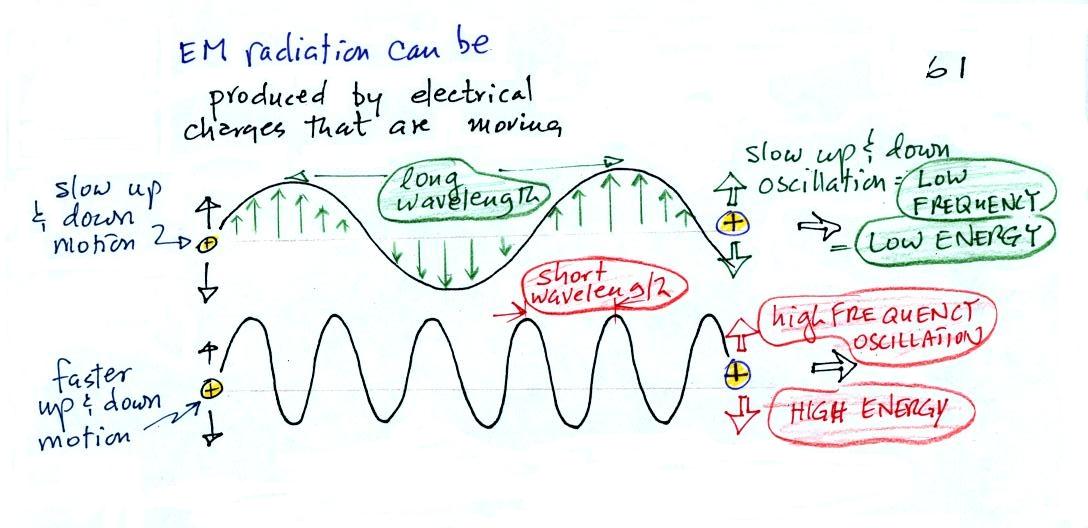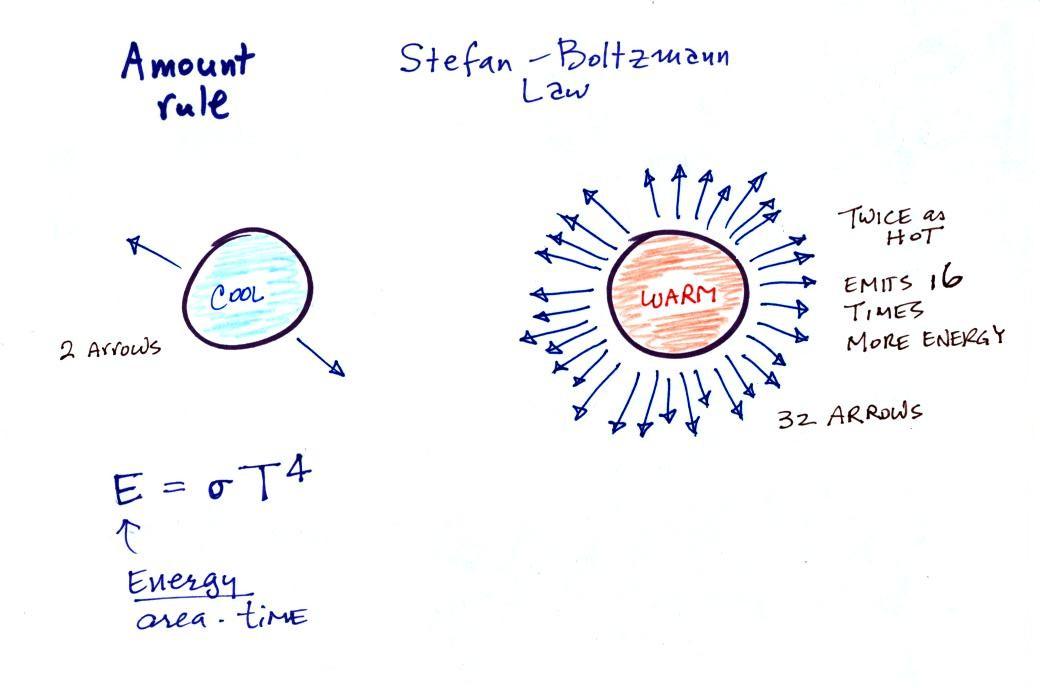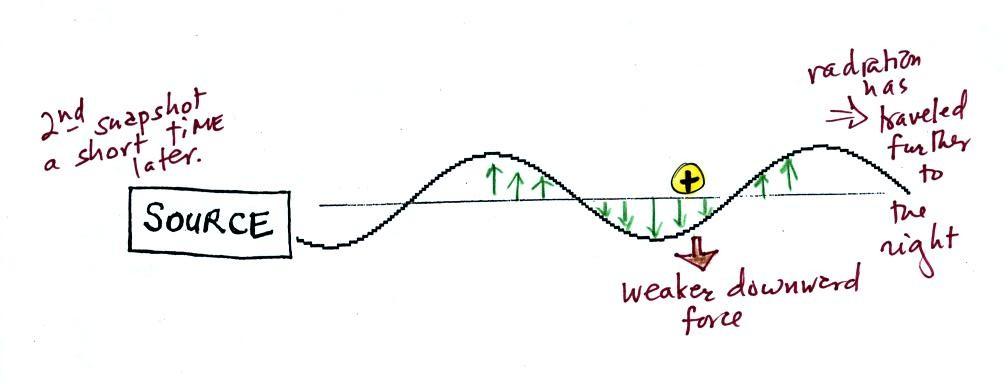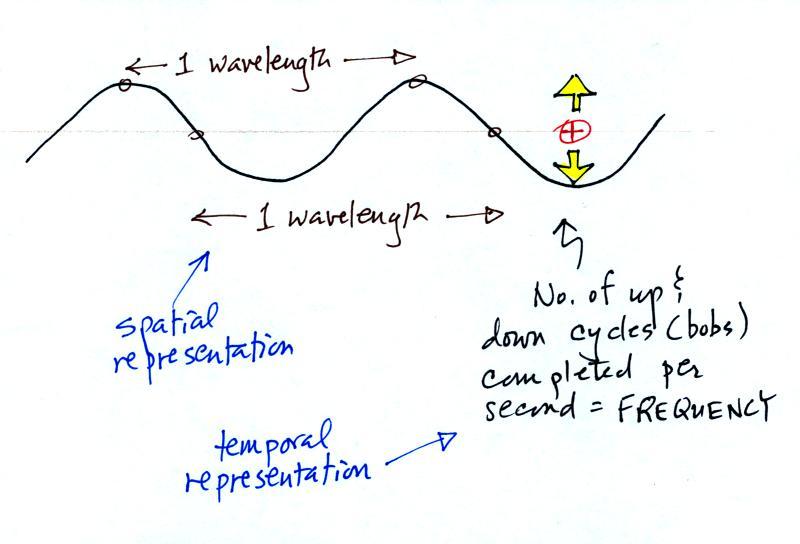Fri., Feb. 28, 2014
Three songs from Playing for Change to choose from before class
today. In the end you heard "Groove in G".
You should listen to their version of Stand By Me
if you've never done so before.
The Upper Level Charts Optional Assignment was returned
today. Unless noted otherwise everyone earned 0.5 pts of
extra credit on this assignment. Almost 30 students also
earned a Green Card.
The Experiment #2 reports (and the materials) are due next
Monday (Mar. 3). Experiment #3 materials will be distributed
next Wednesday or Friday.
At last, It's time to tackle
electromagnetic (EM) radiation, the 4th and most important of the
energy transport processes.
Many textbooks depict EM radiation with a wavy line like shown
above. They don't usually explain what the wavy line
represents.
The wavy line just connects the tips of a bunch of "electric
field arrows". But what exactly are electric field arrows (you
might have heard the term vectors in a physics course).

I think after reviewing a
couple of rules concerning static electricity you'll
be able to understand what electric
field arrows represent. The static electricity rules
are found at the top of p. 59 in the photocopied ClassNotes
Two electrical charges with the same polarity (two positive
charges or two negative charges) push each other apart.
Opposite charges are attracted to each other.
I didn't realize but Jan. 9 this year was National Static
Electricity Day. Here are some picture I found online.

|

|

|
A National Geographic Magazine 2013
Photo Contest winner (source)
|
A cat covered in styrofoam "peanuts"
(source).
Being a cat owner I would worry about the cat swallowing
one of the peanuts and possibly choking.
|
I'm not entirely sure what
this is. Is it a dog, is it
alive? It is so clean it must never
go outdoors. (source)
|
Now onto electric field arrows (or just simply
electric fields)
In this figure a positive charge has
been placed at 3 locations around a center charge.
The electric field arrow shows the direction of the
force that would be exerted on each of the
charges. The force arrow is shown in blue.
The forces range from weak to strong depending on the
distance between the two charges.
Now instead of drawing in the center
charge we have the pattern of electric field arrows that
it would produce.
An electric field arrow
shows the direction and
gives an idea of the strength
of the electrical force
that would be exerted on a positive charge
The E field arrows
show you what would happen to a + charge
at three different locations within the pattern.
You can also use the pattern of electric field arrows to
determine what will happen to a -
charge also.
For a negative charge the force will point in a direction
opposite the E field arrow.
Here are a couple of questions to test your understanding.

First what polarity of charge must be on ground to cause the
charges in the figure below to move as they are doing.
Then what direction does the electric field arrow point at a
location just above the ground where the two charges are found.
Here's a second somewhat harder question that wasn't shown in class.
What is the direction of the electric field arrow at Point X halfway between a +
and a - charge.
You'll find answers to both questions at the end of today's notes.
Now we'll use what we know about electric
fields to start to understand electromagnetic radiation.
You'll find most of the following on p. 60 in the photocopied
ClassNotes.
We imagine turning on a source of EM radiation and then a very
short time later we take a snapshot. In that time the EM
radiation has traveled to the right (at the speed of
light). The EM radiation is a wavy pattern of electric and
magnetic field arrows. We'll ignore the
magnetic field lines. The E field lines sometimes point
up, sometimes down. The pattern of electric field arrows
repeats itself.
Note the + charge near
the right side of the picture. At the time this picture was
taken the EM radiation exerts a fairly strong upward force
on the + charge (we use the
E field arrow at the location of the + charge to determine the direction and strength of
the force exerted on the +
charge).
Th picture above was taken a
short time after the first snapshot after the radiation had
traveled a little further to the right. The EM radiation
now exerts a somewhat weaker downward force on the + charge.
A 3rd snapshot taken a short
time later. The +
charge is now being pushed upward again.
A movie of the + charge,
rather than just a series of snapshots, would show the charge
bobbing up and down much like a swimmer in the ocean would do as
waves passed by.
The wavy pattern used to depict
EM radiation can be described spatially (what you would see in a
snapshot) in terms of its wavelength, the distance between
identical points on the pattern.
Or you can describe the radiation temporally using the
frequency of oscillation (number of up and down cycles completed
by an oscillating charge per second). By temporally we mean
you look at one particular fixed point and look at how things
change with time.

EM radiation can be created when
you cause a charge to move up and down. If you move
a charge up and down slowly (upper left in the figure above) you
would produce long wavelength radiation that would propagate out
to the right at the speed of light. If you move the charge
up and down more rapidly you produce short wavelength radiation
that propagates at the same speed.
Once the EM radiation encounters the charges at the right
side of the figure above the EM radiation causes those charges
to oscillate up and down. In the case of the long
wavelength radiation the charge at right oscillates
slowly. This is low frequency and low energy motion.
The short wavelength causes the charge at right to oscillate
more rapidly - high frequency and high energy.
These three characteristics: long
wavelength / low frequency / low energy go
together. So do short wavelength /
high frequency / high energy. Note that the
two different types of radiation both propagate at the same
speed.
The
following figure illustrates how energy can be transported
from one place to another (even through empty space) in the
form of electromagnetic (EM) radiation.

You add energy when you cause an
electrical charge to move up and down and create the EM
radiation (top left).
In the middle figure, the EM
radiation that is produced then travels out to the right (it
could be through empty space or through something like the
atmosphere).
Once the EM radiation encounters an electrical charge at
another location (bottom right), the energy reappears as the
radiation causes the charge to move. Energy has been
transported from left to right.
This is really just a partial list of some of the different
types of EM radiation. In the top list, shortwave length and
high energy forms of EM radiation are on the left (gamma rays and
X-rays for example). Microwaves and radiowaves are longer
wavelength, lower energy forms of EM radiation.
We will mostly be concerned with just ultraviolet light (UV),
visible light (VIS), and infrared light (IR). Note the
micrometer (millionths of a meter) units used for wavelength for
these kinds of light. The visible portion of the spectrum falls between
0.4 and 0.7 micrometers. UV and IR light are both
invisible. All of the vivid colors shown above are just EM
radiation with slightly different wavelengths. When you see
all of these colors mixed together, you see white light.
Hertz (Hz) is the name given to units of frequency; 1 Hz is 1
cycle per second. The AM radio extends from 550 to 1600 kHz
(kilohertz), I believe. The FM radio band extends from 88 to
108 MHz (megahertz).
We spent most of the rest of the
class learning about some rules governing the emission of
electromagnetic radiation. Here they are:
1.
Everything
warmer than 0 K will emit EM radiation. Everything in the
classroom: the people, the furniture, the walls and the floor,
even the air, are emitting EM radiation. Often
this radiation will be invisible so that we can't see it and
weak enough that we can't feel it (or perhaps because it is
always there we've grown accustomed to it and ignore it).
Both the amount and kind (wavelength) of the emitted radiation
depend on the object's temperature. In the classroom most
everything has a temperature of around 300 K and we will see
that means everything is emitting infrared (IR) radiation with a
wavelength of about 10µm.
2.
The second
rule allows you to determine the amount of EM radiation (radiant
energy) an object will emit. Don't worry about the units
(though they're given in the figure below), you can think of
this as amount, or rate, or intensity. Don't worry about σ (the Greek character rho) either, it is just a
constant. The amount depends on
temperature to the fourth power. If the temperature of an
object doubles the amount of energy emitted will increase by a
factor of 2 to the 4th power (that's 2 x 2 x 2 x 2 = 16).
A hot object just doesn't emit a little more energy than a cold
object it emits a lot more energy than a cold object. This
is illustrated in the following figure:

The cool object is emitting 2
arrows worth of energy. This could be the earth at 300
K. The warmer object is 2 times warmer, the earth heated
to 600 K. The earth then would emit 32 arrows (16 times
more energy).
The earth has a temperature of 300 K. The sun is 20
times hotter (6000 K). Every square foot of the sun's
surface will emit 204 (160,000)
times more energy per second than a square foot of the
earth's surface.
3.
The third
rule tells you something about the kind of radiation emitted by
an object. We will see that objects usually emit radiation
at many different wavelengths but not in equal amounts.
Objects emit more of one particular wavelength than any of the
others. This is called λmax
("lambda max", lambda is the Greek character used to represent
wavelength) and is the wavelength of maximum emission. The
third rule allows you to calculate λmax.
The tendency for warm objects to emit radiation at shorter
wavelengths is shown below.
The cool object is probably emitting infrared light (that
would be the case for the earth at 300 K) so the 2 arrows of
energy are colored red. The warmer object will also emit IR
light but also shorter wavelengths such as yellow, green, blue,
and violet (maybe even some UV if it's hot enough). Remember
though when you start mixing different colors of visible light
you get something that starts to look white. The cool
object might glow read, the hotter object would appear white.
Here are the answers to the two electric field questions
embedded earlier in the notes.
#1
The ground can be either negatively or positively
charged. If the ground were negatively charged the positive
charge would be attracted to the ground and the
negative charge repelled and pushed upward. That's not
what is happening. So the ground must be positively charged.
The positive charge is creating the force that causes the
positive charge to move upward. So that too must be
direction that the electric field arrow is pointing.
#2
To answer the first question we imagine placing a + charge at
Point X.
The center charge will be repelled by the charge on the left
and attracted to the charge on the right. The center charge
would move toward the right.
The electric field arrow shows the direction of the force on
the center charge. The electric field arrow should point
toward the right.


























